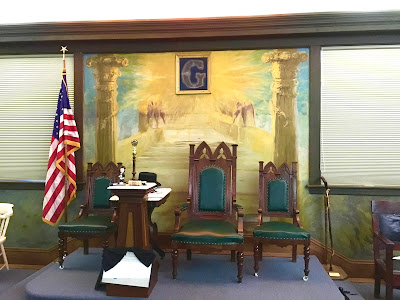My deepest thanks to the members and officers of Arundel Lodge 76 in Kennebunkport, Maine for their kind hospitality on April 25th. Great food, great fellowship - if only that speaker hadn't droned on like a foghorn all night long...
 |
| LtoR: Jonathan Rosen, Worshipful Master Ian Smith, the Dummy, Grand Master Mark Rustin, |
My extra special thanks to Brother Jonathan Rosen for his kind invitation.
It was an honor to have both Grand Master Mark E. Rustin as well as long-time, long-distance friend Ed King (of MasonicInfo.com fame) in attendance. Ed was one of the earliest and most enthusiastic supporters of Freemasons For Dummies and my subsequent books. But much more important, his MasonicInfo.com Anti-Masonry Points of View website was one of the earliest online Masonic resources, and it has grown to more than 350 pages of factual and well-researched material today, touched with Ed's personal asides and wit. He proudly boasts that his website predated Google, and it was one of the first Masonic websites I looked through when I was a very early member of the fraternity. Over the years I have returned to it time and time again when in need of a quick reference. So it was great at last to meet in person.
Arundel Lodge has an absolutely magnificent lodge room, thanks to the talents of an artistic Masons from long ago. In 1930, Kennebunkport's own Brother Lewis Norton painted a continuous mural all the way around the room that depicts the various ages of the Earth in an impressionistic style. The result is positively stunning upon entering the lodge, and becomes endlessly fascinating upon closer inspection.
It was an honor to have both Grand Master Mark E. Rustin as well as long-time, long-distance friend Ed King (of MasonicInfo.com fame) in attendance. Ed was one of the earliest and most enthusiastic supporters of Freemasons For Dummies and my subsequent books. But much more important, his MasonicInfo.com Anti-Masonry Points of View website was one of the earliest online Masonic resources, and it has grown to more than 350 pages of factual and well-researched material today, touched with Ed's personal asides and wit. He proudly boasts that his website predated Google, and it was one of the first Masonic websites I looked through when I was a very early member of the fraternity. Over the years I have returned to it time and time again when in need of a quick reference. So it was great at last to meet in person.
Arundel Lodge has an absolutely magnificent lodge room, thanks to the talents of an artistic Masons from long ago. In 1930, Kennebunkport's own Brother Lewis Norton painted a continuous mural all the way around the room that depicts the various ages of the Earth in an impressionistic style. The result is positively stunning upon entering the lodge, and becomes endlessly fascinating upon closer inspection.
Whether it was intentional or not, it even has an appropriate detail for the northeast corner, which is often a traditional gathering area in many lodges for their Past Masters: a pair of squabbling dinosaurs...






































